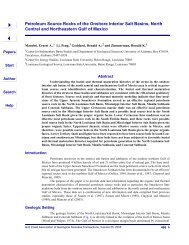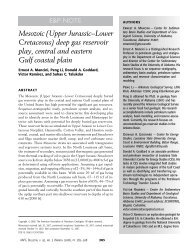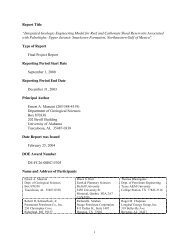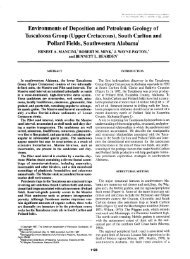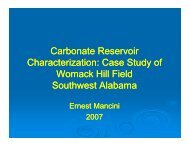Part 4 - Berg - Hughes Center
Part 4 - Berg - Hughes Center
Part 4 - Berg - Hughes Center
Create successful ePaper yourself
Turn your PDF publications into a flip-book with our unique Google optimized e-Paper software.
northwest. These sandstones accumulated on the shelf where they were subsequently<br />
reworked. Kornfeld (1985) stated that proximal destructive delta systems existed in<br />
northern Louisiana and northeastern Texas and that another system consisting of barrier<br />
beaches and bars was located centrally between them.<br />
Environments of deposition located landward from the open Gulf to the south and<br />
paralleling the late Jurassic Gulf of Mexico coastline included a longshore barrier island<br />
in northern Louisiana and a coastal lagoon in southern Arkansas. Sands to the barrier<br />
island were supplied by a delta that was formed by the ancestral Mississippi River in<br />
northeastern Louisiana and adjacent Mississippi (Thomas and Mann, 1966). The<br />
description by these authors and others of the open and shallow marine systems together<br />
with the nearshore coastal features typify the lithofacies of the formations within the<br />
Cotton Valley Group. Updip in southern Arkansas, the uppermost Schuler Formation<br />
pinches out. Of interest are the thick downdip marine deposits in northern Louisiana that<br />
include the following formations: Bossier Shale, Terryville Sandstone, Hicos Shale,<br />
Knowles Limestone, and Schuler Formation. The sedimentary characteristics of the<br />
formations that comprise the group in northern Louisiana are summarized below.<br />
Bossier Shale (Millerton Formation)<br />
The open marine basin deposits of the Bossier Shale are found in northern Louisiana<br />
and consist of dark-gray, fossiliferous, calcareous shale. A wedge of this marine shale<br />
pinches out updip in southernmost Arkansas. It attains a maximum thickness of 2,000 ft<br />
(610 m). The marine shale grades eastward into red shale and sandstone in northeastern<br />
Louisiana (Swain, 1944; Forgotson, 1954). The Haynesville Formation conformably<br />
underlies the Bossier; and where the Haynesville is absent, the Bossier rests on the<br />
357




